

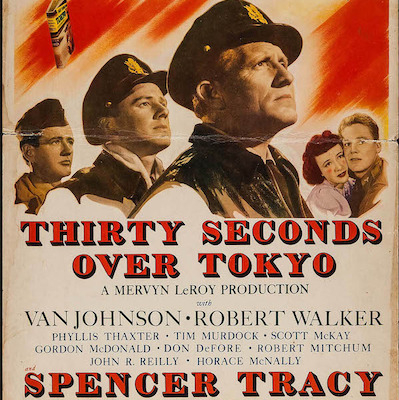
In his book Thirty Seconds Over Tokyo, Doolittle Raid pilot Ted Lawson recalls the moment his B-25 bomber reached the coast of Japan – the first land he had seen, he tells us, after being at sea on the USS Hornet for nearly three weeks. "It looked very pretty," he writes:
"Everything seemed as well kept as a big rock garden. The little farms were fitted in with almost mathematical precision. The fresh spring grass was brilliantly green. There were fruit trees in bloom, and farmers working in their fields waved to us as we pounded just over their heads. A red lacquered temple loomed before us, its coloring exceedingly sharp. I put the nose of the ship up a little, cleared the temple, and got down lower again."
Just a moment earlier Lawson noted that he was "surprised" that the small boats anchored just off the shore "were motor boats and nice-looking fishing launches instead of the junks I expected." Japan was the most industrially advanced of all the Asian nations, and while few Americans knew this at the start of the war this fact would make them a substantially more difficult enemy to defeat in the next four years.
Lawson was also surprised to see men and women on the boats waving at the American bombers flying just over their heads. The Japanese, in their turn, had underestimated the keenness of their American enemy to strike back after the humiliation of Pearl Harbor, and the men in the planes on the Doolittle Raid were shocked at how little resistance they met as they flew in to drop the first of many bombs on the Japanese capitol.
MGM's movie adaptation of Thirty Seconds Over Tokyo was released in November of 1944, two and a half years after the Doolittle Raid. World War Two was in its final stages: a month earlier Allied forces entered Germany and the Battle of Leyte Gulf reduced the Japanese Navy to a spent force. A week earlier Franklin Delano Roosevelt won his fourth and last term as president; in a week the first B-29 air raids of Tokyo would start from Tinian Air Base; in a month the Battle of the Bulge would begin and Major Glenn Miller would disappear during his flight from London to Paris.
Audiences watching the film in theatres had lived through a lot in the last few years, and Hollywood was still putting out plenty of war pictures – 1944 had begun with the release of Destination Tokyo, followed by Gung Ho!, The Fighting Seabees, Eve of St. Mark, The Purple Heart, Song of Russia, Marine Raiders and Wing and a Prayer. It goes without saying that every war picture released while the war was being fought was essentially propaganda, none more so than Thirty Seconds Over Tokyo.
The Doolittle Raid was the first palpable blow against the Japanese Empire in a year full of losses – of territory, of material and of men. In concrete terms it was mostly symbolic, but in hindsight it's regarded as crucial, as the shame of being victims of a surprise attack made the Japanese change their battle plans from a potentially successful lunge south toward Australia and New Zealand to an attempt to prevent another American assault by switching their offense across the Pacific – to the U.S. base at Midway and, if that was successful, to the Hawaiian Islands. Today the outcome of the war looks inevitable, but even in 1944 it was easy to forget how close to disaster we were in the first three years of the conflict.
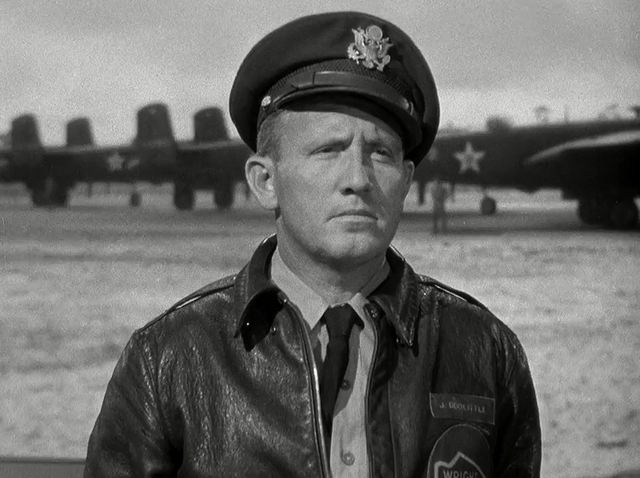
The marquee star of Thirty Seconds Over Tokyo was Spencer Tracy, playing Lt. Col. James Doolittle, the planner of the first air raid on Japan and one of the first American heroes of the war. The truth is that Tracy's role is really just an expanded cameo, and most of the picture centres on Van Johnson playing Lawson, a former air reserve pilot and aspiring aeronautical engineer recently married to his wife Ellen (Phyllis Thaxter).
We see Doolittle in the first scene, in an office of the Department of War with a view of the Capitol Building, pondering a big globe before making a phone call to "York" (Capt. Edward "Ski" York, played by Paul Langton) telling him to get twenty-four B-25s and their volunteer crews to Eglin Field in Florida. A general paces the room and says that this secret mission he's planning might be a big boost for American troops fighting in Singapore and the Philippines; Doolittle tells York that the job will take them out of the country for three months; it's a big load of exposition in just a few lines.
The film cuts to one of those B-25 crews on their way to Florida: Lawson is the pilot, with co-pilot Lt. Dean Davenport (Tim Murdock), navigator Lt. Charles McClure (Don DeFore), bombardier Lt. Bob Clever (Gordon McDonald) and gunner/mechanic Cpl. David Thatcher (Robert Walker). There isn't much given to sketch out their characters, except that McClure avidly shoots home movies and Thatcher is afflicted with air sickness and hails from Billings, Montana.
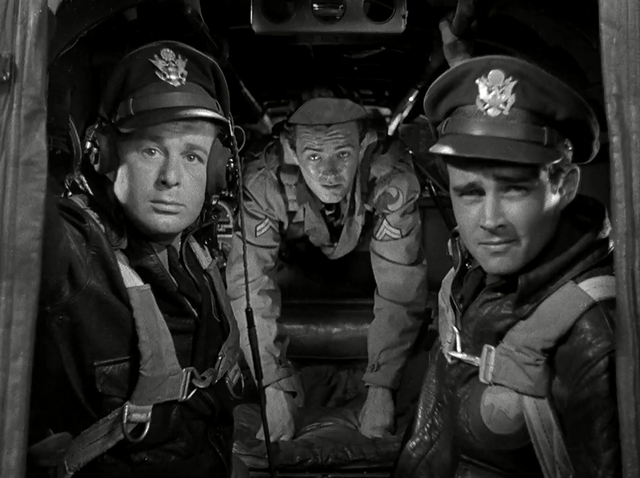
On the ground at Eglin Field we're introduced to the rest of the crews – a bunch of young men who've met before in training or in previous postings, a fraternity of fliers buzzing with esprit de corps. And they meet Doolittle, who stresses to them that the mission is top secret – anyone stranger tries to chat about what they're doing will be reported to the FBI – and extremely dangerous, and that if anyone wants to drop out they should do it immediately and without shame.
We know what they're being asked to do but we watch as the mission reveals itself in stages, starting with a challenge to get fully-loaded twin-engined medium bombers in the air at half the normal speed on a third the usual runway. No one at that point thought it was possible to fly a twin-engined bomber off an aircraft carrier except Doolittle, who had as colourful a career as any flier alive, but Thirty Seconds Over Tokyo doesn't let us know much about that.
There are a lot of pilots and crew onscreen for this part of the picture but few of them get a chance to stand out. One exception is Lt. Bob Gray, played by Robert Mitchum with his customary cool and cynical reserve; he's dubious about why Lawson would take a dangerous mission with a new wife and (it turns out) a baby on the way. The other is Lt. Jacob "Shorty" Manch (John R. Reilly), an unusually tall Virginian and swing music fanatic obsessed with the tune "Deep in the Heart of Texas" (a 1941 hit for Alvino Rey, Ted Weems, Gene Autry and Bing Crosby with Woody Herman). He's the opposite of Mitchum's Gray: an irrepressible cut-up who talks in jive lingo and truly exhausting every time he appears onscreen.
I.Bombed.Tokyo
Lawson wrote a treatment of the book that would become Thirty Seconds Over Tokyo just a few months after returning home, over four nights at the Mayflower Hotel in Washington DC with the help of journalist Bob Considine. They had to wait over a year for the War Department to de-classify information about the Doolittle Raid, at which point the story was serialized in Collier's magazine and then published by Random House.
Friends in Hollywood helped Lawson meet MGM producer Sam Zimbalist, who bought the story and assigned it to director Mervyn LeRoy (Three on a Match, Waterloo Bridge, Random Harvest) and screenwriter (and future blacklist martyr) Dalton Trumbo, who'd had recent hits with Kitty Foyle and A Guy Named Joe.
MGM and LeRoy did their best to stick to the real story of the raid. They used actual USAAF footage of the mission and even shot training scenes at Eglin Field. Lawson's co-pilot, Dean Davenport, acted as technical adviser and stunt flyer on the picture, flying a B-25 off the pier at Santa Monica when all the navy's carriers were unavailable (the Hornet was sunk just six months after the Doolittle Raid at the Battle of the Santa Cruz Islands).
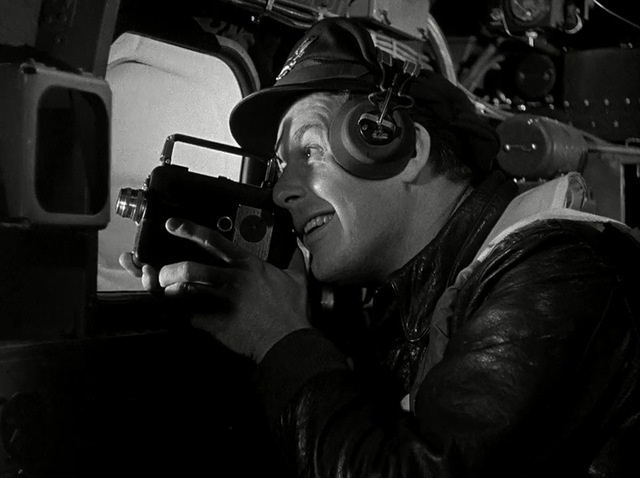
With carrier take-off training finished, Doolittle's crews fly to San Francisco where their planes are loaded onto the Hornet. Their mission is finally revealed and they choose their targets, memorizing maps and routes and learning that the raid is basically a one-way trip – the crews that survive will fly to bases in China where their planes will become part of the air force fighting the Japanese.
They learn that a U.S. submarine has stationed itself off Japan and that the crew surfaces every night to provide reports on weather and the position of barrage balloons for the mission. This would be the story of Destination Tokyo but there's no plausible evidence that this submarine was involved in the execution of the Doolittle Raid.
There's some comic business on the ship involving the fliers getting lost in the labyrinth of the carrier, and how easily they lose their money playing cards with the sailors. There's a scene late at night where Johnson's Lawson and Mitchum's Gray reflect on the mission, the Japanese, and their plans for after the war. The two men decide to go in on a cattle ranch together. (Lawson ended up running a machine shop in California and working as a liaison between an aluminum manufacturer and the U.S. military. Robert Gray died six months after the Doolittle Raid in a plane crash in the Himalayas.)
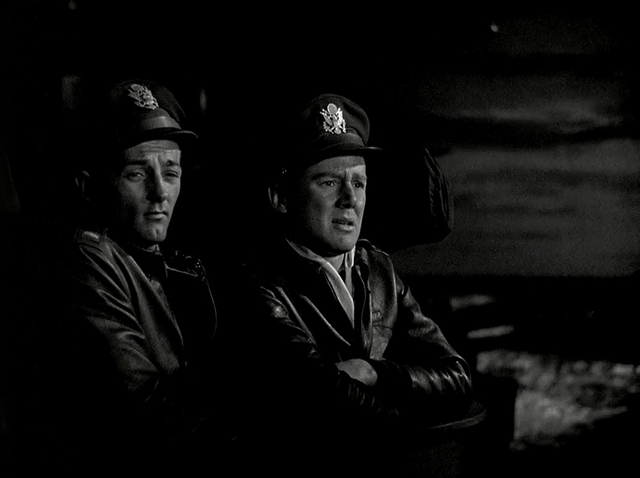
The scene resonates with me for personal reasons; in his discharge documents from the RCAF my father said his plan was to run an orchard on a small holding after the war. (He ended up spending the rest of his life working for Supertest, a Canadian oil and gas company ultimately bought by BP.) I wonder that this peaceful retreat into an agrarian fantasy was apparently common with soldiers fighting the war, and if it was a way of coping with the grimness of war and the regimentation of military life.
The Doolittle Raid was considered a suicide mission, even before a Japanese picket ship was spotted by the Hornet's convoy, forcing the launch of the planes a day and a half and 400 miles further away from their target than planned. Lawson and his crew scramble to get away before the Japanese can attack the convoy, and the improbable business of flying bombers off an aircraft carrier occurs under added pressure, and with the certainty that the planes will run out of fuel before they reach safe airfields in China.
The scenes of Lawson and his crew on The Ruptured Duck flying just above the waves and land before reaching Tokyo is marvellously shot and paced – quality filmmaking on an MGM budget. The bombing of Tokyo is also plausibly imagined, and the whole of their attack from the dropping of the first to last bomb takes just barely over thirty seconds.
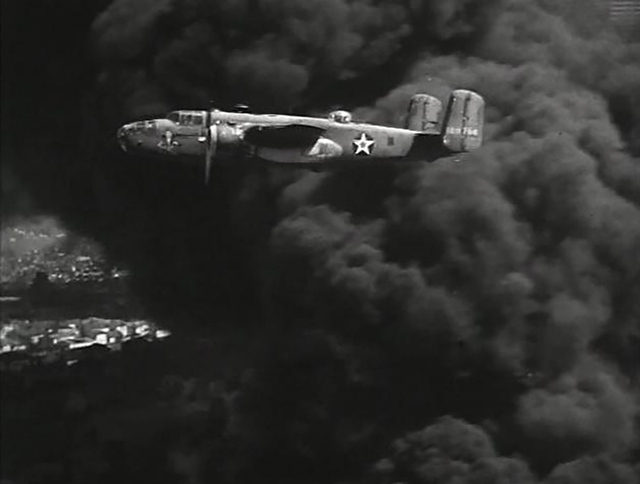
Like Lawson's book, the balance of the film is concerned with how the airmen were rescued and helped by Chinese people and Chiang Kai-shek's soldiers. Of Lawson's five crewmen four were seriously injured when their plane crash landed, with only Cpl. Thatcher relatively unharmed. The men struggle ashore and huddle together at the bottom of the cliff, but Lawson painfully struggles up to look at wreckage of The Ruptured Duck and cry "I lost my ship. I lost my ship."
Johnson's Lawson is shown with a badly mangled leg, but the real Lawson's injuries were far more severe as he and Davenport were ejected, still strapped in their seats, through the plexiglass nose of the plane when its landing gear caught in the water. Lawson's face and jaw were badly damaged and would require reconstructive surgery when he got back to the U.S., but the filmmakers spare Van Johnson this disfiguring indignity.
The injured airmen are carried on litters, along rivers and over mountains, just ahead of the Japanese who launched an offensive along China's eastern coast in search of the airmen, burning towns and murdering locals in reprisal massacres that may have killed up to a quarter of a million people. Eight airmen were captured, tortured and put on trial; they were sentenced to death, though only three of the men were executed and one died of malnutrition in prison.
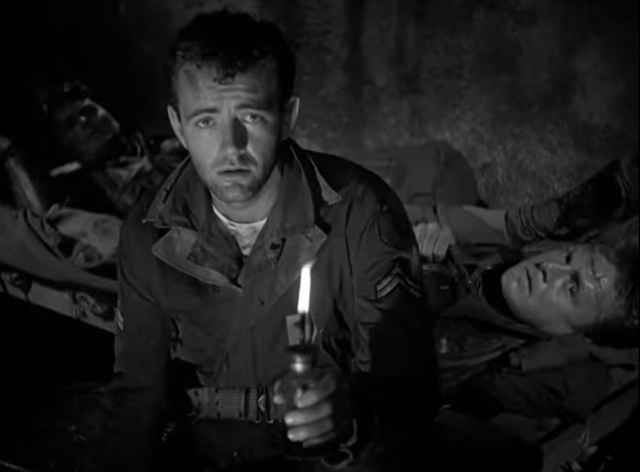
With the help of Chinese doctors and British missionaries the injured airmen are treated, though Lawson has to have his leg amputated, delaying their escape and increasing the threat of capture by the Japanese. The film shows them finally returning home where Lawson tries to get Ellen to stay away until he can get a prosthetic leg and learn to walk on it, but Tracy's Doolittle – an aloof but caring father figure – tells Lawson to trust his wife more, engineering their reunion in a hospital room in Washington with the same view of the Capitol Building dome as the one in that office at the start of the picture.
The film portrays America's Chinese allies only a bit more patronizingly than their Russian allies in wartime propaganda. An old Chinese woman cries in a window as the Americans are moved on; in the next scene the village they leave behind is shown in the distance, in flames. A choir of Chinese children sing the "Star Spangled Banner" for Lawson and the other wounded airmen in a hospital just before they're about to leave China.
Thirty Seconds Over Tokyo is often exceedingly mawkish, starting with its depiction of the relationship between Lawson and Ellen – nowhere near as cloying in the book, where there's no suggestion that he tries to keep her away while he recovers. The most heroic of their Chinese rescuers – including Mr. Charlie (Ching Wah Lee), a guerilla soldier who discovers them after the crash, and the Doctors Chung, father and son physicians (played by Hsin Kung and Benson Fong) who care for the airmen – are praised as "our kind of people".
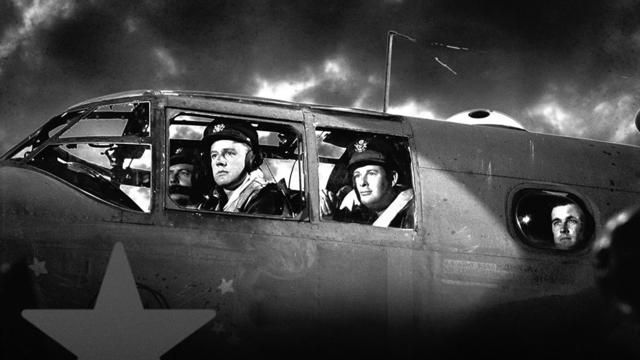
There's even a scene, while The Ruptured Duck is flying across the country, where Lt. Clever, the bombardier, is seen killing time with a drawing of, no joke, mom and apple pie. All of this, along with its copious scenes of hobbling exposition, makes one wonder if Trumbo's reputation as a scriptwriter wasn't a bit overrated. Compared to the best wartime propaganda made at the same time Thirty Seconds Over Tokyo makes, say, Mrs. Miniver look like Apocalypse Now or Come and See.
Jeanine Basinger, writing about the film in The World War II Combat Film: Anatomy of a Genre, observes that Thirty Seconds Over Tokyo is less a combat film than "a domestic drama, a training film, and a personal-battle-with-a-handicap story." Bolero, a 1934 musical starring George Raft and Carole Lombard, has more actual scenes of war and combat, with Raft's coal-miner-turned dancer "seen in the trenches, and a bombing, exploding, shooting, running combat sequence of a few minutes screen time is unleashed, culminating in a wound which puts him in a hospital, with a doctor warning him he will never dance again."
The Doolittle Raid has been an extended sequence in two recent war movies – Michael Bay's execrable Pearl Harbor (2001) and Roland Emmerich's much better Midway (2019), with Doolittle played respectively by Alec Baldwin and Aaron Eckhart. But the story of the raid hasn't been told at length since LeRoy's picture; a well-budgeted feature or a miniseries on HBO or Apple+ is both overdue and might even possibly do justice to every aspect of this desperate moment in WW2 history.
Club members can let Rick know what they think by logging in and sharing in the comments below, as access to the comments section is one of many benefits that comes along with membership in the Mark Steyn Club.
